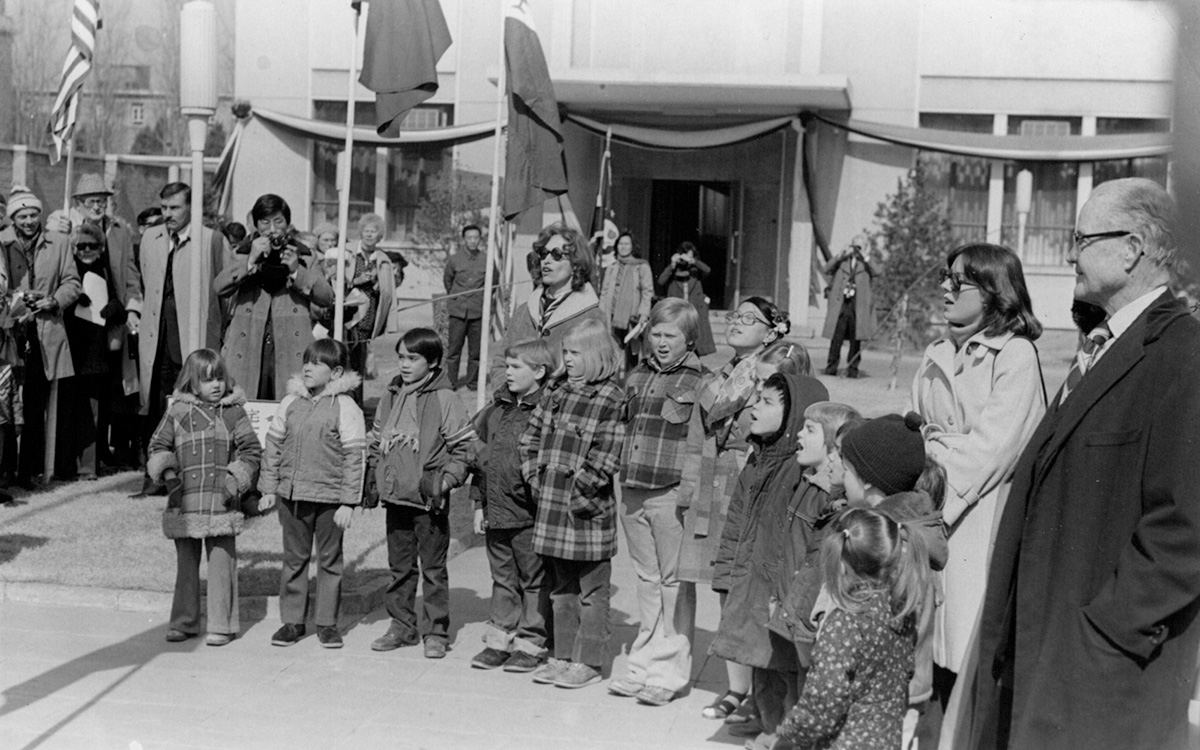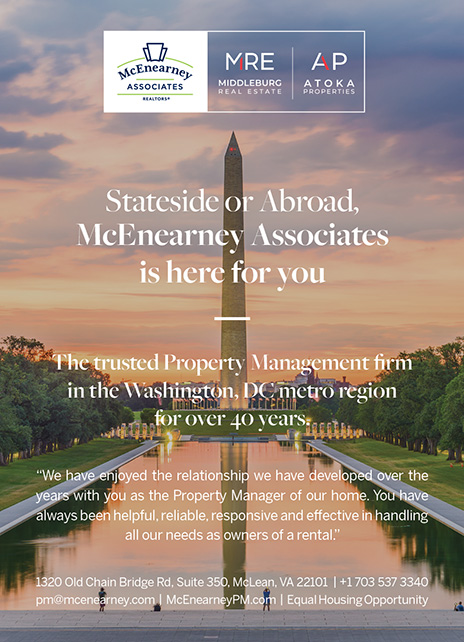Diplomats, Firecrackers, and a Checker Cab: The Opening of U.S. Embassy Beijing
Reflections
BY DON HAUSRATH
After some 45 years, I still find them turning up. Mementos the People’s Republic of China airline had given us: small ceramic pandas, nail clippers with an airline logo, and lapel pins with a golden profile of Chairman Mao. I was awarded these gifts while commuting from Hong Kong to Beijing during the late 1970s. There was no American embassy in Beijing, just a tiny diplomatic enclave called a Liaison Office.
At that time, there were no direct flights between the two cities. You could take the train or the hovercraft on the Pearl River for the 40-mile journey to Guangzhou and then take a train or plane to Beijing.
On the flight a cheerful attendant in a baggy uniform poured tea from a large, dented, blackened metal kettle. She would return with your snack—stewed chicken feet, pickled cabbage, or a similar delicacy … and the souvenirs.

Children of U.S. Liaison Office staff members sing “God Bless America” at the opening of U.S. Embassy Beijing on March 1, 1979.
Courtesy of Don Hausrath
The Liaison Office in Beijing (USLO) was a drab two-story structure about the size of a Denny’s restaurant with a comparable staff. It did not look like the outcome of delicate negotiations between key players in the 20th century.
There had been many secret meetings before USLO was born. Henry Kissinger once “disappeared” for a weekend in Pakistan to meet in Beijing with Mao Zedong. Later, in 1972, came what my Tokyo paper called the Nixon Shokku.
Incredible at the time, Nixon and Mao had initialed declarations that the two nations would work together toward “normalization of relations.” At a followup meeting, Chinese Premier Chou Enlai invented the concept of a “liaison office,” which allowed a handful of American and Chinese diplomats to work in each other’s capitals long before all the details of the regular give-and-take between nations could be established.
Thus, two not-quite-embassies opened, both governments sending some of their most talented diplomats. These pioneers were to struggle for six years in a bureaucratic no-parking zone, eyed suspiciously by their host governments, spied on, phones tapped, and travel strictly controlled.
I commuted to USLO for a few years, still forbidden territory to all but a handful of Americans. I was there for a mundane reason. The now-defunct U.S. Information Agency I worked for believed the best way to work with a foreign country was to let its people learn as much as possible about our government and our culture. I was helping Chinese librarians, long isolated from all things Western, gain access to U.S. information.
A white USLO Toyota van picked me up at the old Beijing airport and dropped me at the Peking Hotel. I did not have a choice. One did not go hotel or apartment hunting; housing needs were handled by the PRC’s Diplomatic Services Bureau.
In their own good time, they would send someone to work for you or tell you where you could live. Many USLO officers waited in the Peking Hotel for weeks, or even months, during which a couple with several small children might be crammed into one room.
The Chinese floor attendant kept the key to your room at a desk on each floor. She would open your door, let you in, and lock the door when you went out. But it wasn’t your key. The hotel staff could, and often did, walk into your room anytime.
A young hotel employee once walked in on our USLO secretary. She was naked, heading for her bath. She shrieked. He yelled. The manager arrived. Our secretary was furious at this intrusion.
But the manager took the employee’s side and chewed out our staffer for embarrassing an innocent young man.
The official limousine was a black-painted, Kalamazoo-made Marathon Checker cab. George Bush, as the first chief of the USLO, lobbied unsuccessfully for a more imposing car, but the State Department allocated perks by the rank of the embassy, and “USLO Peking,” as it was referred to in official cables, was at the bottom of the list.
Bush gave up the fight and sent an exasperated cable stating: “Send Checker, remove meter.” The pug-faced auto would also serve George Bush’s replacement, Ambassador Thomas Gates, a former secretary of defense under Eisenhower. It passed on to Gates’ replacement, Leonard Woodcock, a past president of the United Auto Workers, who tooled about the city in his non-union-made car.
The Chinese staff at the Liaison Office all came and went on bicycles. George Bush and wife Barbara took to sporting about the Forbidden City area on their “Flying Pigeon” bikes. Driving through town, you became accustomed to amazing things strapped to the back wheel of a bike: chairs, desks, small sofas, and the occasional grown pig in a custom-made rattan cage bouncing before you.
In the early days of USLO, besides the stampede of bicycles, you dodged oxen, donkeys, and the occasional three-wheeled truck.

Chargé J. Stapleton Roy helps untangle the old flag at the U.S. Liaison Office in Beijing so a new one can rise over the embassy, March 1979.
Courtesy of Don Hausrath
Finally, the big day came. Twelve children bundled in parkas followed their teacher, Evie Sylvester, wife of the political counselor, to the front steps of the Liaison Office, facing a crowd of about 150 people. Sensing the drama of the occasion, there were no smiles, no waves to parents, no giggles.
The iron-barred front of the compound was three deep in blue-coated Chinese, squeezed against the fence, watching the American flag rising up the pole, the first to fly over an official embassy in China since Dec. 24, 1949.
J. Stapleton “Stape” Roy, the chargé at the new embassy, along with a special representative from President Jimmy Carter, Secretary of the Treasury Michael Blumenthal, snapped a new flag onto the ropes.
Behind a massive brass lectern—its engraved Boxer rebellion history tactfully taped over—Roy stood before the children’s chorus, two of the children his own. “I attended the last Fourth of July party at an American embassy in the People’s Republic of China,” he recounted. “That was in 1949 in Nanking.”
The son of missionaries, Roy was born in Nanking and spoke fluent Chinese like so many at the ceremony. He introduced Secretary Blumenthal, saying, “I particularly asked him to speak in English rather than the Shanghai dialect.”
Still, Blumenthal did, indeed, start off in Chinese. His was another homecoming of sorts. Born in 1926 near Berlin, he, along with his family, escaped one step ahead of the Nazis; they ended up as refugees in China for eight years. To help put food on the table during World War II, teenage Michael worked in a Shanghai chemical factory for $1 per week.
It was minutes before noon on March 1, 1979. The children stood in a semicircle and sang: “… for spacious skies, for amber waves of grain.” Their small voices and those words touched us all.
It was a new start: The United States and the People’s Republic of China had established embassies, an epochal event mostly overlooked today.
Standing in the crowd, I thought how far I was from what the gathering resembled, a sedate church picnic remembered from my Iowa childhood. But church picnics would not have had the leaning bamboo poles heavy with firecrackers and an armed State Department security officer looking down from the roof.
And, of course, there would have been no foreign correspondents, a half dozen chatting it up with Hong Kong Press Attaché Bill Stubbs. Two People’s Liberation Army guards were at our gate in their lumpy winter uniforms: We were still forbidden foreign territory to Beijing’s residents.
But guards or no guards, the isolation of China was ending. Mao’s focus on class struggle and his periodic campaigns against “spiritual pollution” were over. Chinese child prodigies no longer had to muffle their pianos with blankets, fearful of denunciation for playing a bourgeois instrument.
Within just three months of the ceremony, Bill Stubbs’ staff had assisted in enrolling 3,000 postdoctoral and graduate students in scientific and technical specializations in American universities.
The opening of the embassy coincided with China’s acknowledgment of the need to rebuild. The Roys would return to Beijing again in 1991, when Stape was named U.S. ambassador to the PRC, to find a cosmopolitan city bursting with construction. USLO was ancient history.
“For the most part,” Sandy Roy confided to me later, “USLO was an adventure. It was definitely not Little League and ballet classes, but our family would not have traded our three years there for anything.”
When sharing or linking to FSJ articles online, which we welcome and encourage, please be sure to cite the magazine (The Foreign Service Journal) and the month and year of publication. Please check the permissions page for further details.




